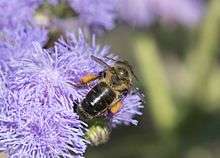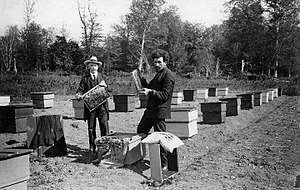Caucasian honey bee
| Caucasian honey bee | |
|---|---|
 | |
| Scientific classification | |
| Kingdom: | Animalia |
| Clade: | Euarthropoda |
| Class: | Insecta |
| Order: | Hymenoptera |
| Family: | Apidae |
| Genus: | Apis |
| Species: | A. mellifera |
| Subspecies: | A. m. caucasia |
| Trinomial name | |
| Apis mellifera caucasia Pollmann, 1889 | |
| Synonyms | |
| |
The Caucasian honey bee (Apis mellifera caucasia,[1] commonly misspelled caucasica[2]) is a subspecies of the Western honey bee.
Origin
The Caucasian honey bee originates from the high valleys of the Central Caucasus. Georgia is the “central homeland” for the subspecies, although the bees also can be found in eastern Turkey, Armenia and Azerbaijan.[3]
Anatomy and Appearance
- Shape and Size: similar to A. m. carnica
- Chitin Color: dark with brown spots at times
- Hair Color: lead-grey
- Tongue Length: up to 7.2 mm
Behavior
beneficial for beekeeping
- Gentle and calm on the comb
- Longest proboscis, so it can extract nectar from the deepest nectar tissues, where no other species can
- Ardent brood production - raising strong colonies
- Colonies reach full strength in mid-summer, which is good for areas where the highest nectar flow is in mid-summer
- Very great user of propolis
- In its native area a better honey producer than the European dark bee
not beneficial for beekeeping
- Colonies do not reach full strength until mid-summer, which is an undesirable trait for areas with the highest nectar flow in the spring.
- The great use of propolis may be seen as undesirable as it makes hive management more difficult. Frames and hive boxes are glued together more substantially.
- Over wintering in northern climates not good due to susceptibility to nosema
- Inclined to drifting and robbing
Worldwide distribution

The Caucasian (Georgian) honeybee has a long history of importance to beekeeping worldwide. The bees were first introduced in the United States in 19th century. Caucasian honey bee was a subspecies that came to have enduring interest to U.S. beekeepers. Frank Benton (1852-1919) visited Georgia in 1905 and supported the import of honeybees to the United States. [4]
Russian Revolution and consequent annexation of Georgia by Red Army in 1921 halted the export of Caucasian bees. Subspecies were studied and cultivated primarily by Soviet entomologists. Soviet officials were concerned about preserving the purity of Caucasian species and outlawed any export without special permission. [5]
International exports were continued from 1969. According to UK newspaper "GOLDEN BEE the grey mountain bee of the Soviet Union has been judged the best in the world and awarded a gold medal. The grey caucasian bee is distinguished for its industry and it collects honey, even when it is raining. Many foreign beemasters have requested for the Golden bee and as many as 200 000 have been sent to Europe, Asia and America this year." (Sunday Mirror June, 1 1969) [6]
International awards
Caucasian (Georgian) honey bee received 3 gold medals at the international events - at the International Exhibition of Gardening in Erfurt (Germany) in 1961; at the 20th APIMONDIA International Congress in Bucharest (Romania) in 1965; and at the 23rd APIMONDIA International Congress in Moscow in 1971. [7] [8]
Sources
The Hive and the honeybee, Chapter 11 Races of bees by Prof. Friedrich Ruttner, published by Dadant 1975
- ↑ Michael S. Engel (1999). "The taxonomy of recent and fossil honey bees (Hymenoptera: Apidae: Apis)". Journal of Hymenoptera Research. 8: 165–196.
- ↑ NBC Taxonomy
- ↑ http://www.eurasianet.org/node/66821
- ↑ Status of breeding practices and genetic diversity in domestic U.S. honey bees
- ↑ https://goldenbee.ge/en/info.htm
- ↑ Sunday Mirror June, 1 1969
- ↑ National Geographic
- ↑ APIMONDIA International Federation of Beekeepers' Associations